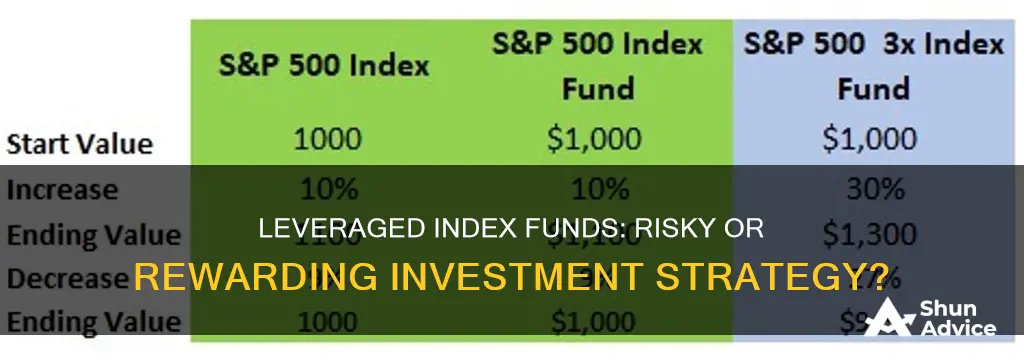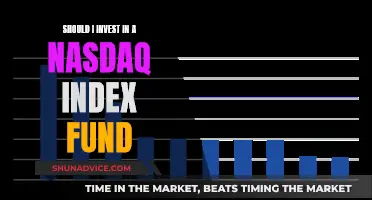
Index funds are a type of investment fund that tracks the performance of a particular stock market index, such as the S&P 500. They are designed to provide investors with a diversified portfolio of stocks that mirror the index's performance. While investing in index funds can be a passive way to invest in the stock market, some investors seek to enhance their returns by using leverage. Leverage essentially means borrowing money to increase the amount of investment, with the goal of amplifying potential gains. However, it's important to note that leverage can also amplify losses, and there are several risks associated with investing in leveraged index funds. In this article, we will explore the potential benefits and drawbacks of investing in leveraged index funds and provide insights into whether it is a suitable investment strategy.
| Characteristics | Values |
|---|---|
| Returns | Leveraged index funds amplify the daily return of a particular index through the use of debt. For example, a 3x leveraged S&P 500 index fund would magnify a 1% gain to a 3% gain and a 1% loss to a 3% loss. |
| Risk | The amplification of daily returns happens on both the positive and the negative side. If the index loses 33% in a single day, a 3x leveraged holding would be completely wiped out. Leveraged index funds are therefore unsuitable for long-term investment strategies. |
| Costs | Leveraged index funds have higher fees and expense ratios compared with traditional ETFs. |
What You'll Learn

Leveraged index funds amplify daily returns
However, this also works in the opposite direction, leading to magnified losses. If the underlying index falls by 1%, the loss is magnified by the leverage. For example, a 1% loss becomes a 3% loss.
The use of derivatives for generating returns is known as "synthetic replication", which is more efficient than borrowing to buy securities. Derivatives used include futures contracts, forward contracts, total return swaps, and options.
The Securities and Exchange Commission (SEC) first allowed leveraged exchange-traded funds (LETFs) in 2006. Analysts have been concerned about their effect on market volatility as they can magnify major swings. They are meant for day-to-day trading and are not suitable for long-term investments.
Bloomberg's Best Investment Fund Options: Where to Start?
You may want to see also

The risks of leveraged index funds
Leveraged index funds, or LETFs, are a type of security that uses financial derivatives and debt to amplify the returns of an underlying index or other assets it tracks. While they offer the potential for significant gains, they also come with considerable risks that investors should be aware of. Here are some of the key risks associated with leveraged index funds:
- Magnified Losses: The most significant risk of investing in LETFs is the potential for magnified losses. Since LETFs aim for a higher return than the underlying index through the use of leverage, any losses in the index will be amplified. For example, if the underlying index loses 1% in a day, a 3x leveraged fund will lose 3%. In a highly volatile market, this can result in substantial losses for investors.
- High Fees and Expenses: LETFs typically have higher fees and expense ratios compared to traditional ETFs. These funds have to pay premiums, fees, and interest on the derivatives they use, as well as margin costs. The higher fees can eat into the returns of the fund, reducing overall profitability.
- Not Suitable for Long-Term Investing: Leveraged index funds are designed for short-term trading and are not suitable for long-term investment strategies. The daily reset mechanism in LETFs causes them to rebalance their portfolios daily, which can cause longer-term returns to diverge significantly from simply compounding the underlying index's returns. As such, LETFs are best suited for day traders and not long-term investors.
- Increased Volatility: The use of leverage in LETFs can lead to increased volatility in investment portfolios. The amplified gains and losses can result in higher risk compared to traditional ETFs. This volatility may not be suitable for all investors, especially those with a low-risk tolerance.
- Complex Nature: LETFs are complex financial instruments that use derivatives such as futures contracts, forward contracts, and swaps to generate returns. Understanding how these derivatives work and their potential impact on investment portfolios is crucial. Investors should have a clear understanding of the mechanics of LETFs before investing.
- Regulatory Scrutiny: Due to their potential impact on overall market volatility, LETFs are under perennial regulatory scrutiny. The Securities and Exchange Commission (SEC) has expressed concern about their effect on market swings. As such, investors should be aware of the potential regulatory risks associated with these instruments.
- Underperformance in Bear Markets: While LETFs can boost returns during bull markets, they can underperform during bear markets. In periods of significant market declines, the magnified losses in LETFs can result in substantial wealth destruction. For example, during the coronavirus crash in 2020, a 3x leveraged ETF of the S&P 500 declined by 77% compared to a 33% decline in the underlying index.
A Simple Guide to Mutual Funds: Investing Your First $100
You may want to see also

The costs of leveraged index funds
Leveraged index funds, or LETFs, are complex financial instruments that come with higher costs than traditional ETFs. These costs can eat into investors' returns and should be carefully considered before investing.
Firstly, LETFs have higher fees and expense ratios compared to traditional ETFs. This is because they employ derivatives such as futures contracts, forward contracts, total return swaps, and options, which incur premiums, fees, and interest charges. These derivatives are necessary for the daily rebalancing that LETFs require. The constant rebalancing and use of derivatives result in higher transaction costs for LETFs.
Secondly, the management fees associated with LETFs can be significant. The management expense, which covers marketing and fund administration, can be more than 1% of the fund's assets.
Thirdly, interest costs are built into the pricing of derivatives used by LETFs. These interest rates are typically close to the short-term rate on government securities.
Lastly, the impact of daily rebalancing on the performance of LETFs cannot be understated. The daily reset mechanism causes LETFs to rebalance their portfolios daily to maintain their target leverage ratio, which can cause longer-term returns to diverge significantly from simply compounding the underlying index's returns. This means that LETFs may not achieve a consistent return compared to the tracked index over longer periods.
In summary, while LETFs offer the potential for significant gains, they also come with higher costs and fees that can diminish returns. It is important for investors to carefully consider these costs and understand the mechanics of LETFs before investing.
Managed Funds: Choosing and Investing in a Smart Way
You may want to see also

Leveraged index funds vs. long-term investing
Leveraged index funds are a type of security that uses financial derivatives and debt to amplify the returns of an underlying index or other assets it tracks. They are designed to deliver multiples of the daily performance of a specific index or asset, such as the S&P 500 or Nasdaq 100 Index. These funds aim for a higher ratio, typically 2:1 or 3:1, compared to traditional ETFs, which track on a one-to-one basis.
For example, if you invest in a 3x leveraged S&P 500 index fund and the index gains 1% in a day, your daily return will be magnified by three, resulting in a 3% gain. However, if the index loses 1%, you will also lose 3%. This structure of amplifying daily returns applies to both positive and negative sides, leading to significant gains or losses.
When considering leveraged index funds vs. long-term investing, it's important to understand the risks and potential drawbacks. Here are some key points to consider:
Risks and Drawbacks:
- Volatility and Losses: The most significant risk of leveraged index funds is the potential for substantial losses. The amplification of daily returns means that any decline in the underlying index will be magnified, leading to larger losses. During periods of high volatility or market downturns, leveraged index funds can underperform and severely erode investments.
- Fees and Costs: Leveraged index funds, also known as leveraged ETFs, often have higher fees and expense ratios compared to traditional ETFs. The use of derivatives and leverage incurs additional costs, including management fees, interest, and transaction expenses. These fees can eat into the investor's returns over time.
- Rebalancing Impact: Leveraged ETFs require constant rebalancing to maintain their target leverage ratio, typically 2x or 3x. This rebalancing can lead to higher costs and impact the fund's performance, especially during volatile markets. The daily reset mechanism can cause longer-term returns to diverge from simply compounding the underlying index's returns.
- Not Suitable for Long-Term: Leveraged ETFs are designed for short-term trading and are not suitable for long-term investment strategies. The complex nature of these funds, along with the impact of daily rebalancing, makes them unpredictable over longer periods. They are meant for day-to-day or intraday trading, and their results over longer periods can be unpredictable.
- Complexity and Experience: Leveraged index funds are more complex than traditional investments. Experienced investors who are comfortable managing their portfolios may prefer to control their index exposure and leverage ratios directly rather than through leveraged ETFs.
- Underperformance: Over time, leveraged ETFs may underperform due to the ups and downs of the market. The costs of leverage and the impact of volatility can lead to long-term underperformance compared to the underlying index.
Potential Benefits:
- Potential for Significant Gains: Leveraged index funds offer the possibility of substantial gains that exceed the tracked index or assets. During favourable market conditions, the amplification of daily returns can result in outsized returns.
- Hedge Against Losses: Leveraged ETFs can be used as a hedge against potential losses. Inverse leveraged ETFs, for example, are designed to perform oppositely to their index, making them useful for short-term defensive strategies.
- Diversification and Exposure: Like traditional ETFs, leveraged ETFs provide diversification and exposure to various indexes, sectors, or asset classes. They allow investors to benefit from the economies of scale by joining a large pool of invested funds.
In conclusion, when considering leveraged index funds vs. long-term investing, it's essential to understand the risks and potential benefits. While leveraged index funds offer the opportunity for significant gains, they also carry a higher level of risk and complexity. These funds are more suitable for short-term trading by experienced investors who can actively manage their portfolios and are willing to accept higher risk. For long-term investing, traditional ETFs or other investment vehicles are generally recommended due to their lower risk profile and more predictable performance.
ICICI Prudential Bluechip Fund: Is It Worth Your Investment?
You may want to see also

The pros and cons of leveraged index funds
Leveraged index funds, or LETFs, are a type of security that uses financial derivatives and debt to amplify the returns of an underlying index or other assets it tracks. While they offer the potential for significant gains, they also come with considerable risks and drawbacks. Here are some of the pros and cons of investing in leveraged index funds:
Pros:
- Potential for Significant Gains: LETFs offer the possibility of substantial returns that exceed the tracked index or assets. This makes them attractive to investors seeking higher profits.
- Wide Variety of Securities: Investors have a diverse range of securities to trade using LETFs, providing flexibility and opportunities to invest in various markets.
- Profiting from Market Declines: Inverse LETFs allow investors to make money when the market is declining. This strategy, known as short-selling, enables investors to profit from bearish market conditions.
Cons:
- Significant Losses: While LETFs can amplify gains, they can also magnify losses. A decline in the underlying index can lead to exaggerated losses for investors, potentially eroding investments quickly.
- Higher Fees and Expenses: LETFs typically have higher fees and expense ratios compared to traditional ETFs. The use of derivatives and margin costs contribute to these increased expenses.
- Not Suitable for Long-Term Investments: LETFs are designed for short-term trading strategies due to their daily rebalancing nature. They are not intended for long-term investment horizons as their results over longer periods are unpredictable and can compound losses.
- Complex Nature: LETFs employ complex financial instruments, such as derivatives, which can be challenging to understand for some investors. The use of derivatives also makes LETFs more sensitive to market fluctuations.
- Tracking Errors: Due to the compounded effects of leverage, LETFs may not reliably mirror the index performance over the long term. The returns generated by LETFs can significantly diverge from the simple multiplier of the underlying index's returns, especially during volatile market conditions.
- Counterparty Risk: The use of over-the-counter derivatives in LETFs introduces counterparty risk, which is the risk that the other party involved in the trade defaults.
- Timing Sensitivity: Leveraged ETFs require precise short-term market timing, which is extremely difficult to achieve consistently.
Property Funds: A Smart Investment Strategy for Diversification
You may want to see also
Frequently asked questions
A leveraged index fund amplifies the daily return of a particular index through the use of debt. For example, if you bought a 3x leveraged S&P 500 index fund, your daily return would be magnified 3x. If the S&P 500 gains 1% in a day, you gain 3%.
Leveraged index funds can boost your returns when the market is performing well. They can also be used to hedge against potential losses.
Leveraged index funds can also amplify losses when the market is performing badly. For example, if the S&P 500 loses 1% in a day, you would lose 3%. Leveraged index funds are also subject to higher fees and expense ratios compared with traditional ETFs.
Leveraged index funds are likely only appropriate for experienced investors who have a high tolerance for risk.







